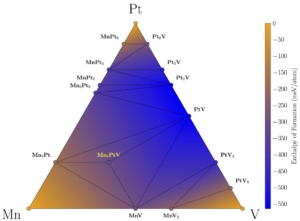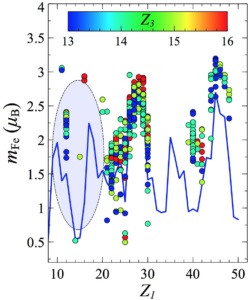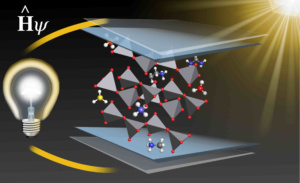About 250,000 inorganic compounds are known to mankind, of which only about 100,000 have been thoroughly characterized crystallographically. On the one hand this is very large set, so that finding the most appropriate material for a given application may be a rather difficult task. On the other hand, 250,000 is still a rather small number compared to all possible materials that can be formed by simply combining the elements of the periodic table over the available crystal structure prototypes. The goal of our materials design effort is that of solving the inverse problem in materials science, namely that of designing the most appropriate compound, or family of compounds, tailored for given specific applications. Here are a few on-going projects in this area:
High-throughout discovery of novel high-performing magnets
In collaboration with the group of Prof. Stefano Curtarolo at Duke University we are undergoing a significant effort aimed at discovering novel magnetic materials. We have created a library of more than 300,000 Heusler alloys prototypes (a ternary compound of type X2YZ) and screened them for thermodynamical stability and magnetic properties (e.g. magnetic moment, critical temperature TC). A preliminary searched performed over about one quarter of the prototypes has revealed 20 new magnets. In collaboration with the group of Prof. Coey, at Trinity College, we have attempt the grown of a few with a 50% success rate. This is the first time that magnets are discovered systematically from the periodic table outset.
References:
[3] Stefano Sanvito, Corey Oses, Junkai Xue, Anurag Tiwari, Mario Zic, Thomas Archer, Pelin Tozman, Munuswamy Venkatesan, Michael Coey, and Stefano Curtarolo. Accelerated discovery of new magnets in the Heusler alloy family. Science Advances 3, e1602241 (2017). [2] Stefano Curtarolo, Gus L. W. Hart, Marco Buongiorno Nardelli, Natalio Mingo, Stefano Sanvito, and Ohad Levy. The high-throughput highway to computational materials design. Nature Materials 12, 191 (2013). [1] Stefano Curtarolo, Wahyu Setyawan, Shidong Wang, Junkai Xue, Kesong Yang, Richard H. Taylor, Gus L. W. Hart, Stefano Sanvito, Marco Buongiorno Nardelli, Natalio Mingo, and Ohad Levy. Aflowlib.org: a material property consortium repository for high-throughput ab initio calculations. Comp. Mat. Sci. 58, 227 (2012).
Machine learning for magnetism
 Machine learning methods allow one to discover patterns in large datasets. These numerical techniques are widely used in data science with applications ranging from natural language processing to risk assessments. Their use in materials science is relatively new, but it has the potential of enabling the discovery of new physical laws and to optimize both experimental and theoretical research. Our research program aims at using both theoretical and experimental data to identify patterns in magnetism so that properties, which are complex and time consuming to calculate (e.g. the critical temperature or the magneto-crystalline anisotropy), can be estimated by using a handful of elementary physical-chemical properties readily available (e.g. chemical composition, crystal structure, etc.). Projects in this area include the use of experimental data to predict the Curie temperature of ferromagnets and the use of structural information about the ionic chemical environment to predict the magnetic moments of Fe-containing Heusler alloys.
Machine learning methods allow one to discover patterns in large datasets. These numerical techniques are widely used in data science with applications ranging from natural language processing to risk assessments. Their use in materials science is relatively new, but it has the potential of enabling the discovery of new physical laws and to optimize both experimental and theoretical research. Our research program aims at using both theoretical and experimental data to identify patterns in magnetism so that properties, which are complex and time consuming to calculate (e.g. the critical temperature or the magneto-crystalline anisotropy), can be estimated by using a handful of elementary physical-chemical properties readily available (e.g. chemical composition, crystal structure, etc.). Projects in this area include the use of experimental data to predict the Curie temperature of ferromagnets and the use of structural information about the ionic chemical environment to predict the magnetic moments of Fe-containing Heusler alloys.
References:
[1] Mario Žic, Thomas Archer, Stefano Sanvito, Designing magnetism in Fe-based Heusler alloys: a machine learning approach, arXiV:1706.01840 (2017).
Design of novel solar harvesting compounds
 Designing new materials for solar energy harvesting is a complex process since several properties (e.g. light absorption efficiency, charge transport, recombination rates, etc.) combined together determine the final efficiency of a device. Here we develop descriptors to estimate such a multitude of properties so that we can navigate a large materials space in the search for high-performing solar energy compounds. Our research has a high-throughput aspect, where we screen large computational materials dataset, and a more conventional one, based on various levels of density functional theory, where we examine in detail the properties of some selected compounds. At present most of our effort is devoted to hybrid and all-inorganic perovskites, in particular including those presenting ferroelectric order, and composites made by stacking different 2D layered compounds (e.g. MoS2/WS2). Some of the work is carried on in collaboration with the Qatar Energy and Environment Research Institute (QEERI).
Designing new materials for solar energy harvesting is a complex process since several properties (e.g. light absorption efficiency, charge transport, recombination rates, etc.) combined together determine the final efficiency of a device. Here we develop descriptors to estimate such a multitude of properties so that we can navigate a large materials space in the search for high-performing solar energy compounds. Our research has a high-throughput aspect, where we screen large computational materials dataset, and a more conventional one, based on various levels of density functional theory, where we examine in detail the properties of some selected compounds. At present most of our effort is devoted to hybrid and all-inorganic perovskites, in particular including those presenting ferroelectric order, and composites made by stacking different 2D layered compounds (e.g. MoS2/WS2). Some of the work is carried on in collaboration with the Qatar Energy and Environment Research Institute (QEERI).
References:
[4] Fedwa El Mellouhi, Akinlolu Akande, Carlo Motta, Sergey N. Rashkeev, Golibjon Berdiyorov, Mohamed El-Amine Madjet, Stefano Sanvito, Sabre Kais, and Fahhad H. Alharbi. Solar cells materials by design: Hybrid pyroxene corner-sharing VO4 tetrahedral chains. ChemSusChem 10, (2017). [3] Pankaj Mandal Carlo Motta and Stefano Sanvito. Effects of molecular dipole orientation on the exciton binding energy of CH3NH3PbI3. Phys. Rev. B 94, 045202 (2016). [2] Carlo Motta, Fedwa El Mellouhi, and Stefano Sanvito. Charge carrier mobility in hybrid halide perovskites. Scientific Reports 5, 12746 (2015). [1] Carlo Motta, Fedwa El Mellouhi, Sabre Kais, Nouar Tabet, Fahhad Alharb, and Stefano Sanvito. Revealing the role of organic ligands in hybrid halide perovskites CH3NH3PbI3. Nature Communication 6, 7026 (2015).
Modelling composite materials for high-temperature high-pressure applications
Aerospace applications require materials able to withstand extreme conditions, such as ultra-high temperatures, large thermal shocks, high pressure and a very aggressive chemical environment. In some cases (e.g. in commercial aviation) high-melting point metals represent the solution, but often these are not sufficient. Within the C3harme consortium we investigate composites obtained by incorporating carbon fibers into matrices made of refractory ceramics such as ZrB2. Our approach consists first into looking at the mechanical properties of the ceramics and into identifying which are the surfaces mostly likely to be exposed to the fiber. Then we study the adhesion of the fibers to the matrix. Such results are then used by our collaborators into finite elements large-scale simulators and form a dataset from which to construct efficient numerical force fields. These allow meso-scale simulations of the mechanical properties of the composites.
